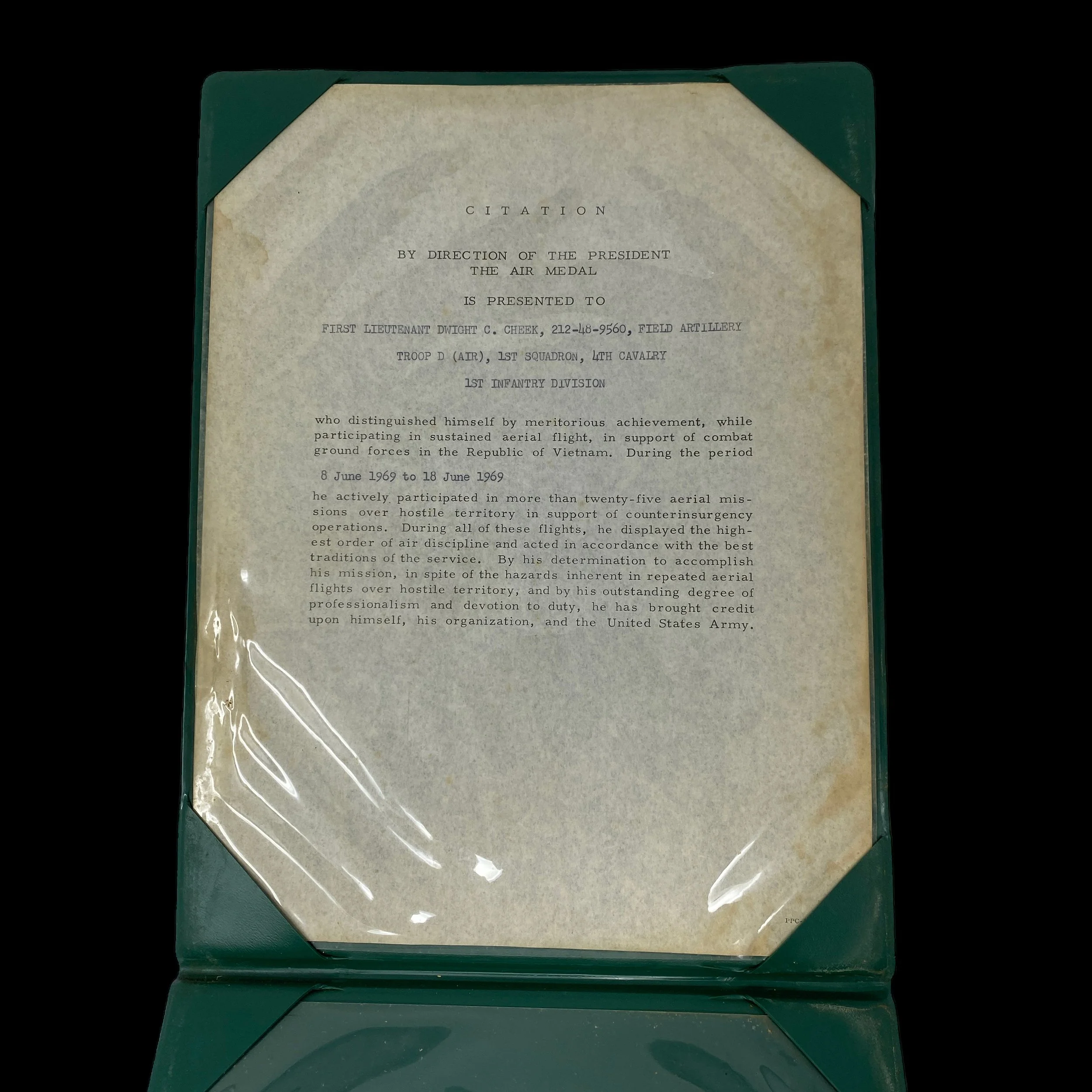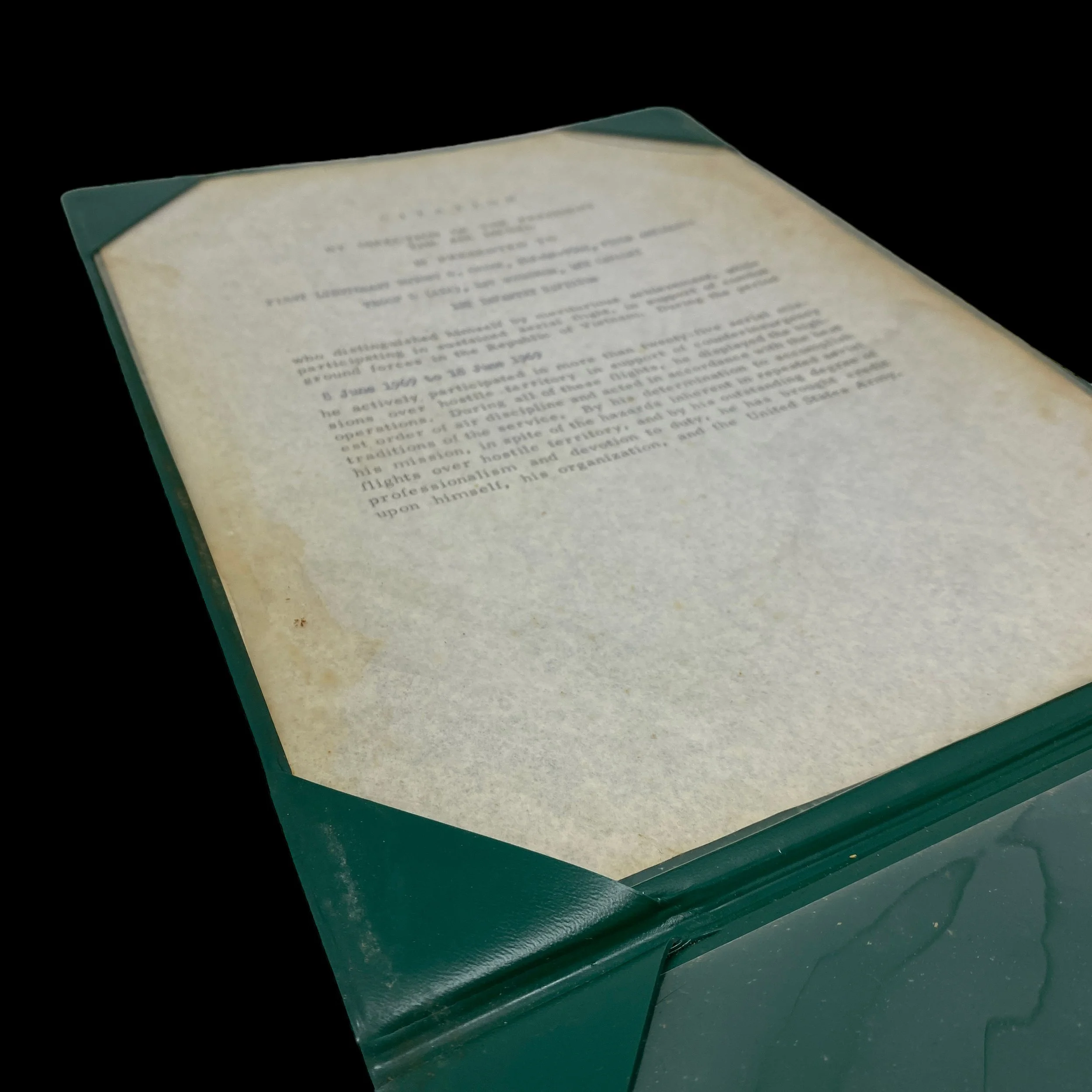RARE! June 1969 Vietnam War Air Medal Citation to 1st Lieut. Dwight C. Cheek - 1st Squadron, 4th Calvary Regiment, 1st Infantry Division, Troop D (AIR)













RARE! June 1969 Vietnam War Air Medal Citation to 1st Lieut. Dwight C. Cheek - 1st Squadron, 4th Calvary Regiment, 1st Infantry Division, Troop D (AIR)
Comes with C.O.A.
This rare and museum-grade Vietnam War Air Medal Citation was awarded to 1st Lieut. Dwight C. Cheek (212-48-9560) of the 1st Squadron, 4th Calvary Regiment, 1st Infantry Division, Troop D (AIR). To qualify for the Air Medal, pilots and aircrew had to demonstrate exceptional proficiency in their duties. They had to exhibit exceptional airmanship, navigation, and mission planning skills. Additionally, they had to show exceptional bravery in the face of enemy fire and demonstrate a willingness to put their own safety at risk to complete their mission. This air medal citation was awarded under the direction of the president for combat service from June 8, 1969 to June 18, 1969.
As an Air Cavalry veteran of the infamous “Quarterhorses” the 1st Squadron, 4th Calvary Regiment provided a third dimension to the cavalry effort, reaching farther and faster into the battle space than any other manned weapon system. Troop D (AIR) provided helicopter support for the 1st Infantry Division and acted as air cavalry, a new concept in the Army. The 1st Squadron participated in eleven campaigns of the Vietnam War from 20 October 1965 to 5 February 1970. The 1st Squadron was awarded the Presidential Unit Citation for its heroism in Binh Long Province and a Valorous Unit Award for Binh Doung Province. The 1st Squadron received a Valorous Unit Award for its actions at the battle of Ap Bau Bang. 1st Lieut. Dwight C. Cheek’s primary missions were to act as the forward eyes of the Squadron and Division. During this tour in Vietnam, 1st Lieut. Dwight C. Cheek became a highly decorated Air Calvary soldier being awarded the Distinguished Flying Cross for heroism in aerial flight and two Bronze Stars and 18 Air Medals.
Throughout the Vietnam War, the troopers of the 1st Squadron, 4th Cavalry Regiment participated in numerous battles and operations including; Operation Niagara, Operation Cedar Falls, Operation Williston, Operation Tucson-Delta, Operation Junction City, Operation Manhattan, Operation Shenandoah II (where Troop C handed the VC one of their heaviest defeats of the war, the Tet Offensive, and many more in numerous small villages along the Cambodia-South Vietnam border, and throughout South Vietnam. Meanwhile, Troop D provided helicopter support for the 1st Infantry Division and acted as air cavalry, a new concept in the Army. The 1st Squadron participated in eleven campaigns of the Vietnam War from 20 October 1965 to 5 February 1970. The 1st Squadron was awarded the Presidential Unit Citation for its heroism in Binh Long Province and a Valorous Unit Award for Binh Doung Province. Troop A, 1st Squadron received a Valorous Unit Award for its actions at the battle of Ap Bau Bang.
Full History of the 1st Squadron:
1st Squadron, 4th Cavalry (1-4 Cavalry, popularly called "Quarterhorse") was assigned to be the divisional reconnaissance squadron of the 1st Infantry Division based at Di An. It arrived at Vung Tau on 7 October 1965, making it the first element of the 4th Cavalry to deploy to Vietnam. Commanded by LTC Paul M. Fisher, the Squadron was ready for action. On 12 November 1965, 1-4 Cavalry received its baptism by fire in the Vietnam War when Troop A, attached to 2-2 Infantry, engaged a VC regiment in the village of Bau Bang. Three enemy probing attacks were thrown back, and on the fourth charge, .50 caliber machine-gun fire broke up their assault and the enemy retreated, leaving 146 dead. On 24 February 1966, Troop B fought a stiff skirmish with the VC and repulsed the enemy. In April 1966, LTC Fisher became the executive officer of the 1st Brigade, 1st Infantry Division, and his replacement was LTC Leonard L. Lewane. LTC Lewane led the squadron in several operations in conjunction with other elements of the 1st Infantry Division, including Operations Birmingham, El Paso, and Shenandoah.
On 8 June 1966, during Operation El Paso II, Troop A, en route to An Loc, was ambushed by the VC 272nd Regiment along Route 13. The battle lasted 5 hours and resulted in 14 US and 19 South Vietnamese killed. VC losses were 105 dead (body count) and it was estimated that the bodies of a further 200+ were removed. For their courage, Troop A was awarded the Vietnamese Cross of Gallantry. On 30 June 1966, HQ, Troops B, C, D and C Company 2-18 Infantry engaged the VC 271st Regiment while conducting reconnaissance and managed to kill 300 VC during the seven-hour battle. On 9 July, 1-4 Cav troopers engaged the enemy again in the Battle of Minh Thanh Road and killed 250 VC. For these three engagements, the squadron was awarded the Presidential Unit Citation.
Throughout the Vietnam War, the troopers of 1st Squadron, 4th Cavalry Regiment participated in numerous battle and operations including; Operation Niagara, Operation Cedar Falls, Operation Williston, Operation Tucson-Delta, Operation Junction City, Operation Manhattan, Operation Shenandoah II (where Troop C handed the VC one of their heaviest defeats of the war, the Tet Offensive, and many more in numerous small villages along the Cambodia-South Vietnam border, and throughout South Vietnam. Meanwhile, Troop D provided helicopter support for the 1st Infantry Division, and acted as air cavalry, a new concept in the Army. The 1st Squadron participated in eleven campaigns of the Vietnam War from 20 October 1965 to 5 February 1970. The 1st Squadron was awarded the Presidential Unit Citation for its heroism in Binh Long Province as well as a Valorous Unit Award for Binh Doung Province. Troop A, 1st Squadron received a Valorous Unit Award for its actions at the battle of Ap Bau Bang.
Air Medal & Vietnam War:
The Air Medal is a military decoration awarded by the United States Armed Forces to personnel who have demonstrated exceptional acts of heroism or meritorious service in aerial flight. The Air Medal was first created in 1942, and since then, it has been awarded to thousands of servicemen and women who have shown exceptional courage, skill, and dedication in the skies. During the Vietnam War, the Air Medal was a highly coveted award, and many pilots and crewmembers were honored with this decoration for their service in this conflict.
The criteria for receiving the Air Medal during the Vietnam War were based on the individual's performance in aerial flight. Specifically, pilots and aircrew had to complete a certain number of combat missions to qualify for the award. The number of missions varied depending on the branch of service and the specific aircraft used, but typically, aircrew had to complete at least 25 combat missions to be eligible for the Air Medal.
To qualify for the Air Medal, pilots and aircrew had to demonstrate exceptional proficiency in their duties. They had to exhibit exceptional airmanship, navigation, and mission planning skills. Additionally, they had to show exceptional bravery in the face of enemy fire and demonstrate a willingness to put their own safety at risk to complete their mission.
During the Vietnam War, pilots and aircrew faced numerous challenges in the skies. They had to fly in all weather conditions, day or night, and they had to fly in some of the most hostile airspace in the world. The enemy had advanced anti-aircraft systems, including surface-to-air missiles (SAMs), that posed a significant threat to American aircraft. To make matters worse, the enemy was often difficult to distinguish from friendly forces, which put American pilots and aircrew at risk of fratricide.
Despite these challenges, American pilots and aircrew demonstrated remarkable courage and skill in their service during the Vietnam War. They flew countless combat missions, often under the most hazardous conditions, and they helped to achieve critical objectives in the conflict. Many of these pilots and aircrew were awarded the Air Medal in recognition of their service.
In addition to the criteria for individual performance, the Air Medal was also awarded for meritorious service. This meant that pilots and aircrew who demonstrated exceptional leadership or contributed significantly to the overall success of their unit or operation could also be eligible for the award.
The Air Medal was a highly coveted award during the Vietnam War, and it represented a significant achievement for those who received it. It recognized the bravery, skill, and dedication of American pilots and aircrew who faced enormous challenges in the skies over Vietnam. The award symbolized the sacrifices made by those who served in this conflict, and it remains an important symbol of honor and achievement in the United States Armed Forces today.
In conclusion, the Air Medal is a highly respected military decoration that recognizes the exceptional performance of pilots and aircrew in aerial flight. During the Vietnam War, the award was a significant achievement that recognized the bravery and dedication of American pilots and aircrew who served in this conflict. To qualify for the award, individuals had to demonstrate exceptional skill and bravery in the face of significant challenges. The Air Medal remains an important symbol of honor and achievement in the United States Armed Forces, and it serves as a reminder of the sacrifices made by those who serve our country.